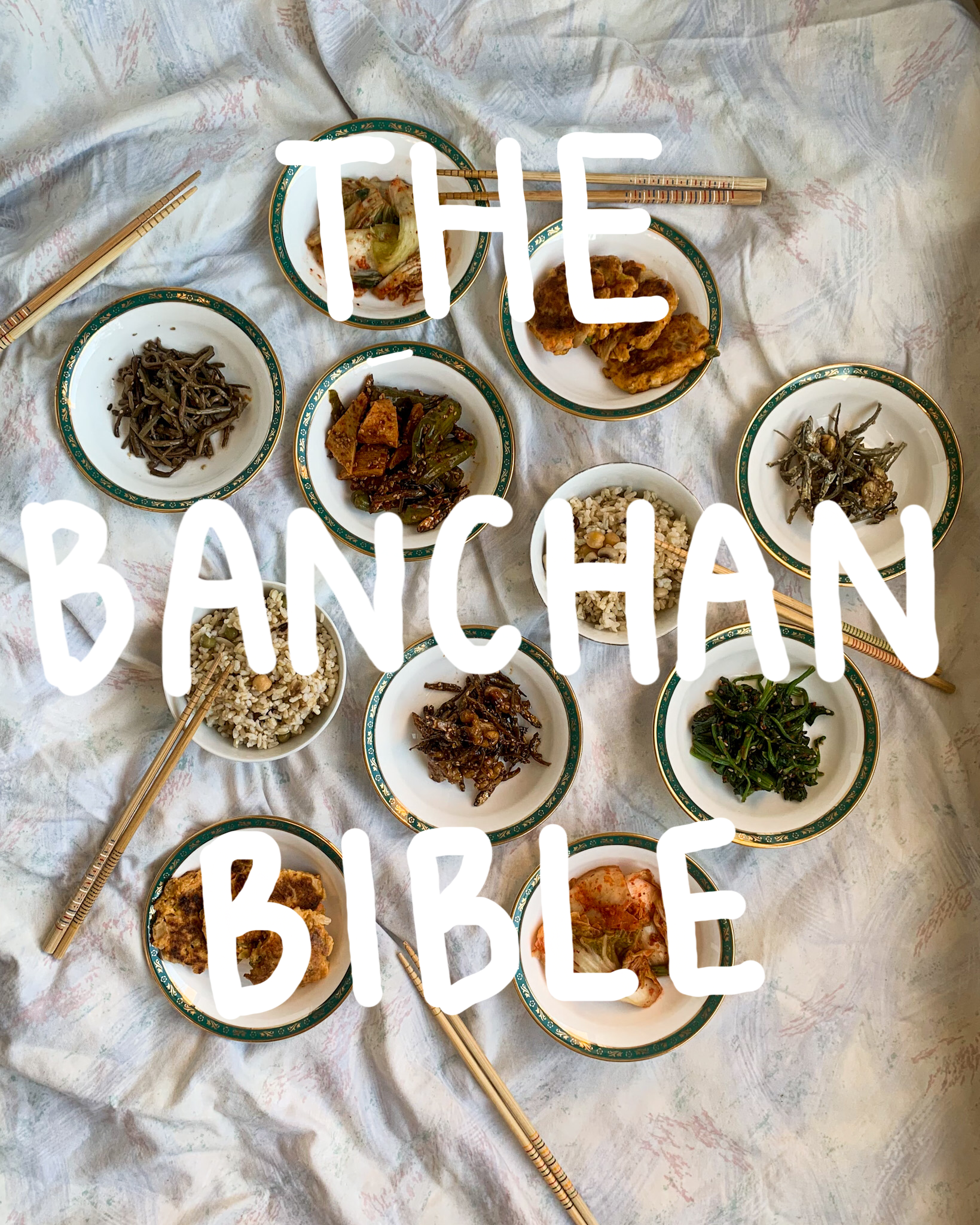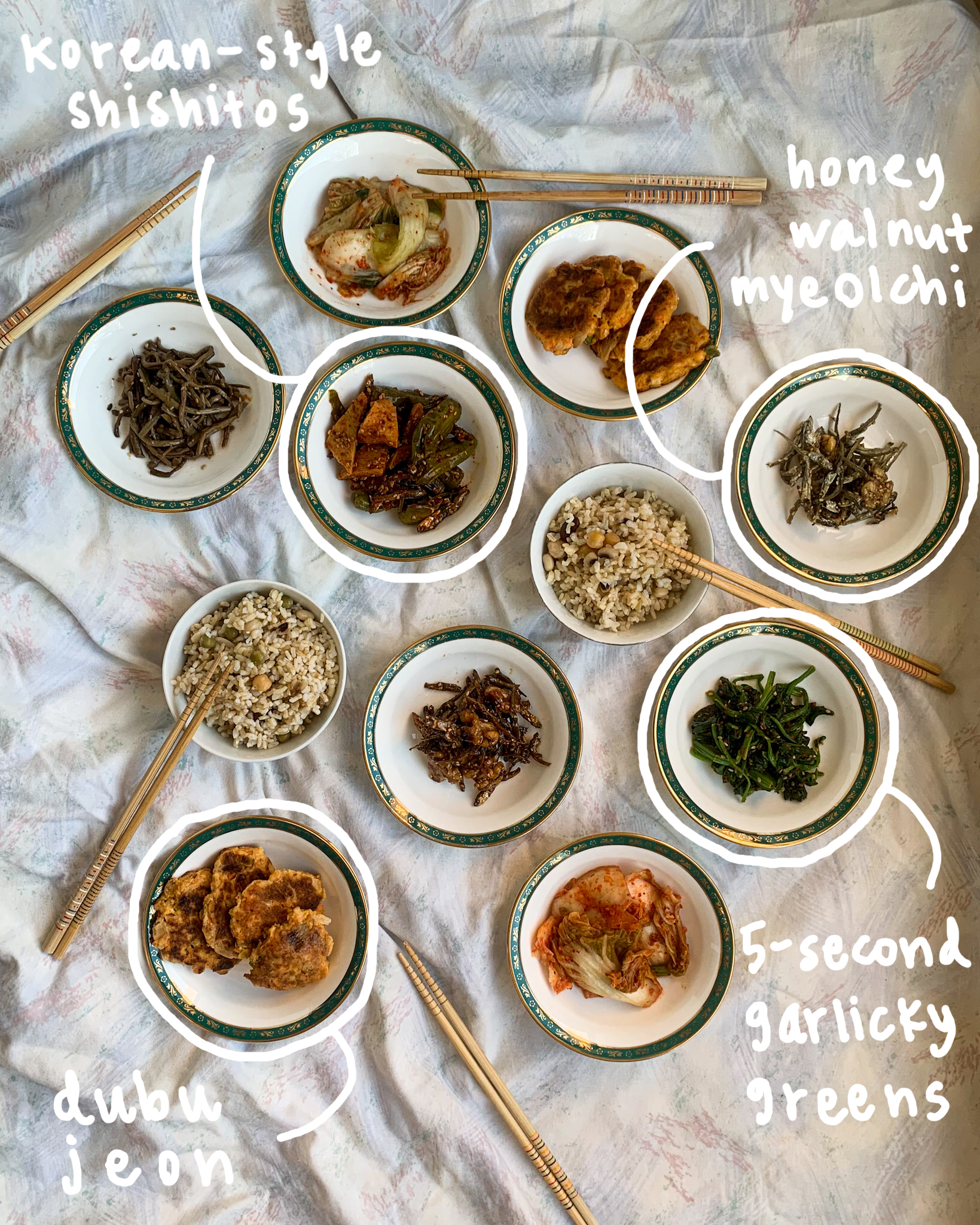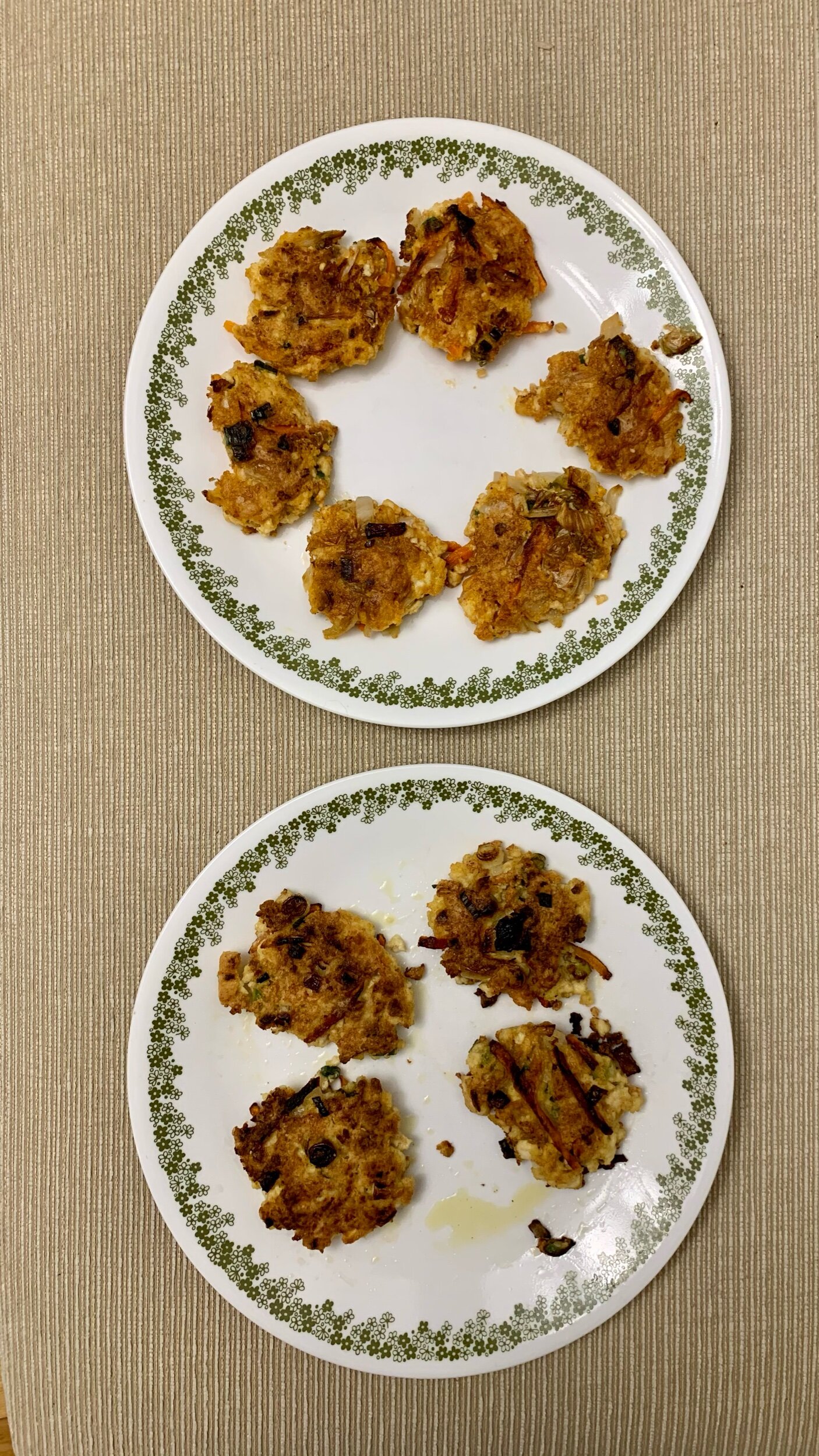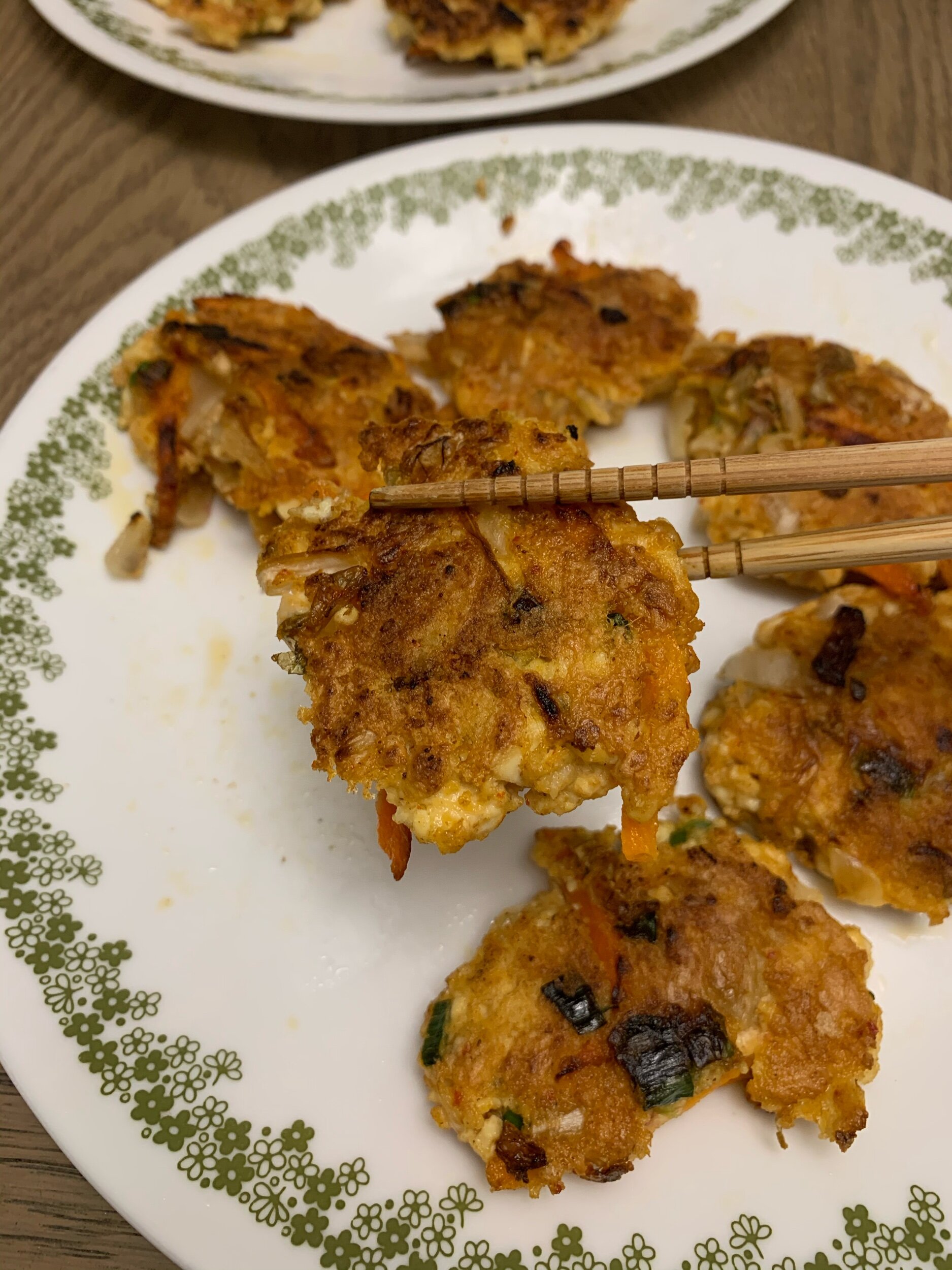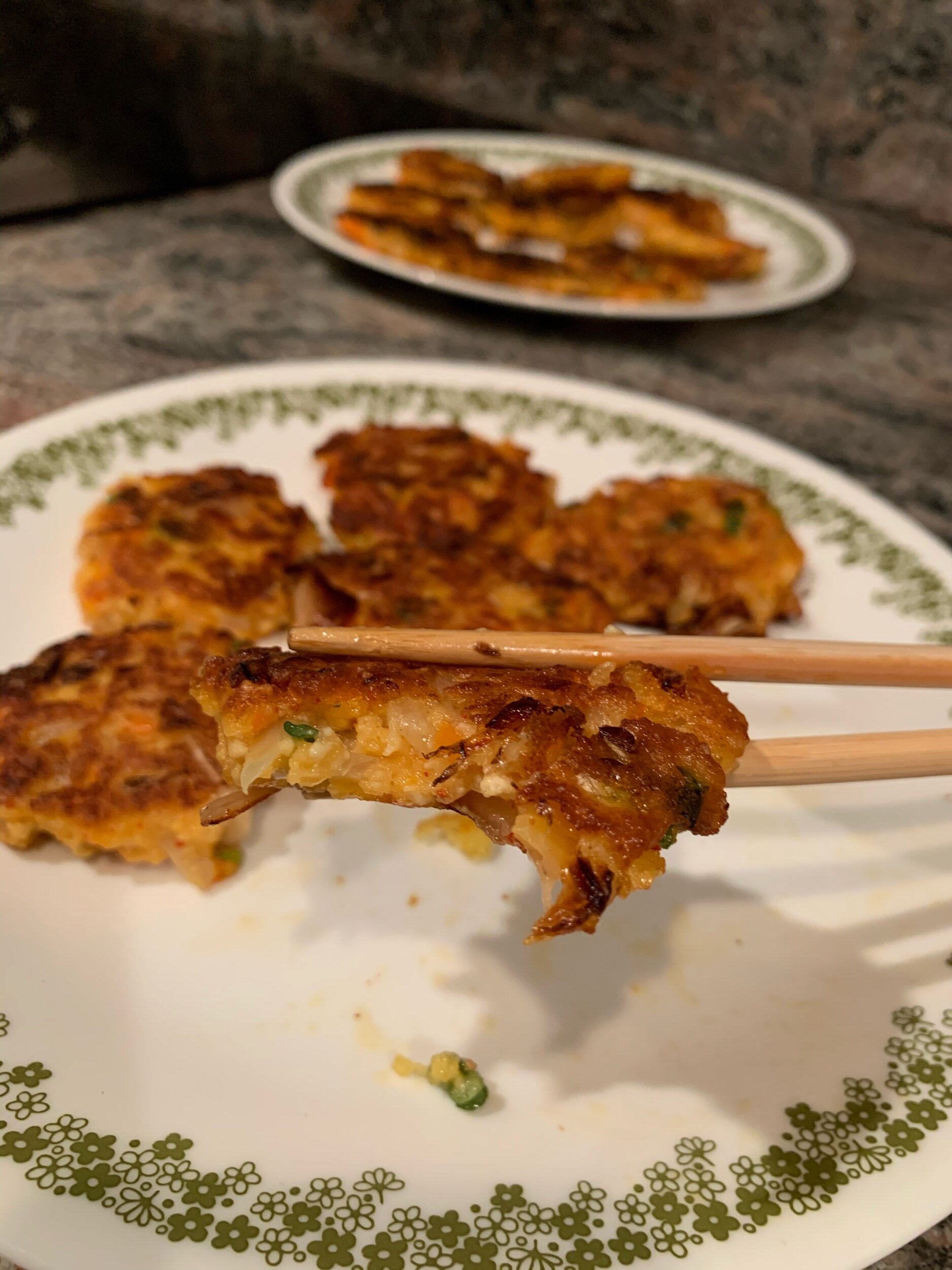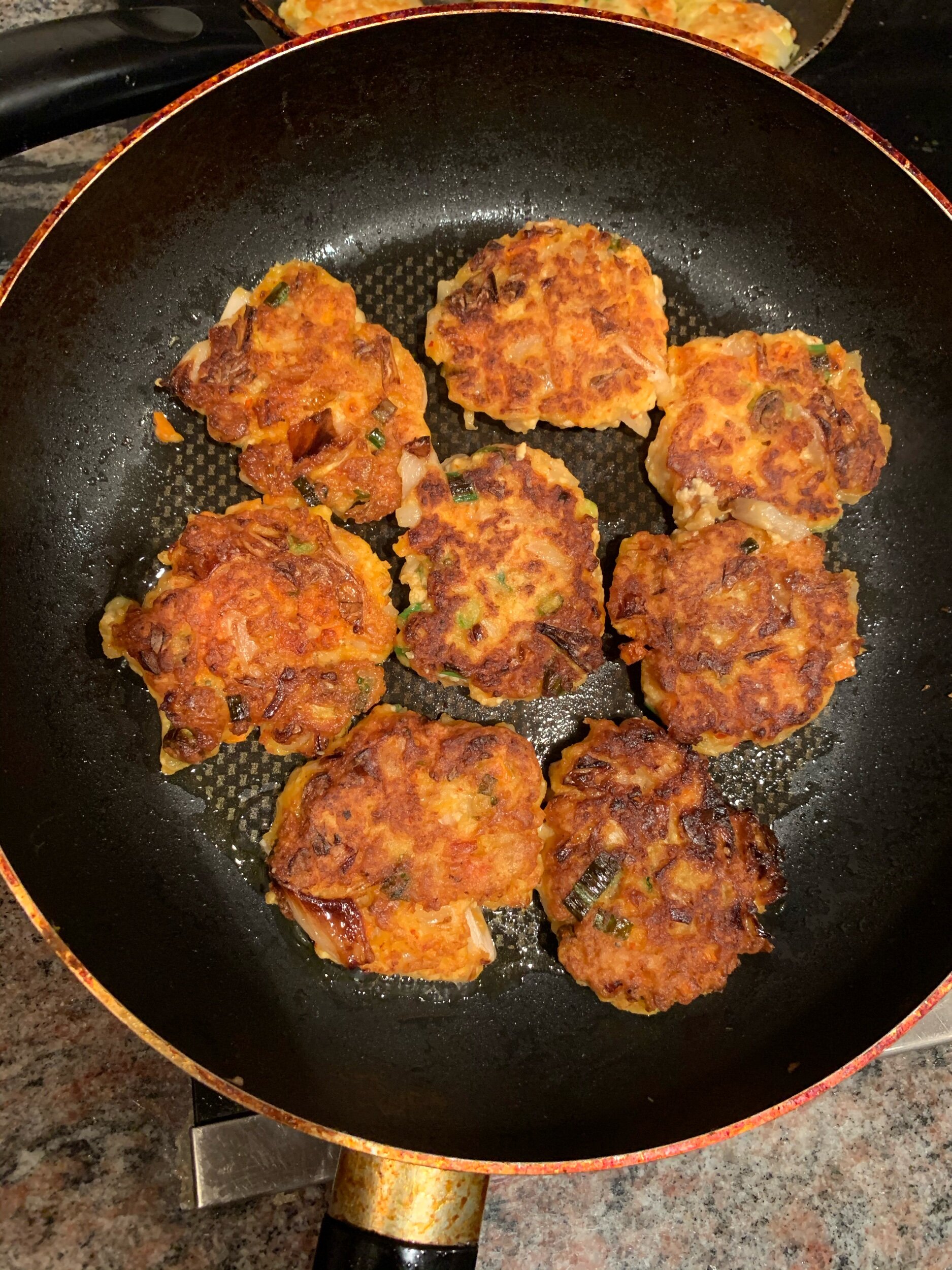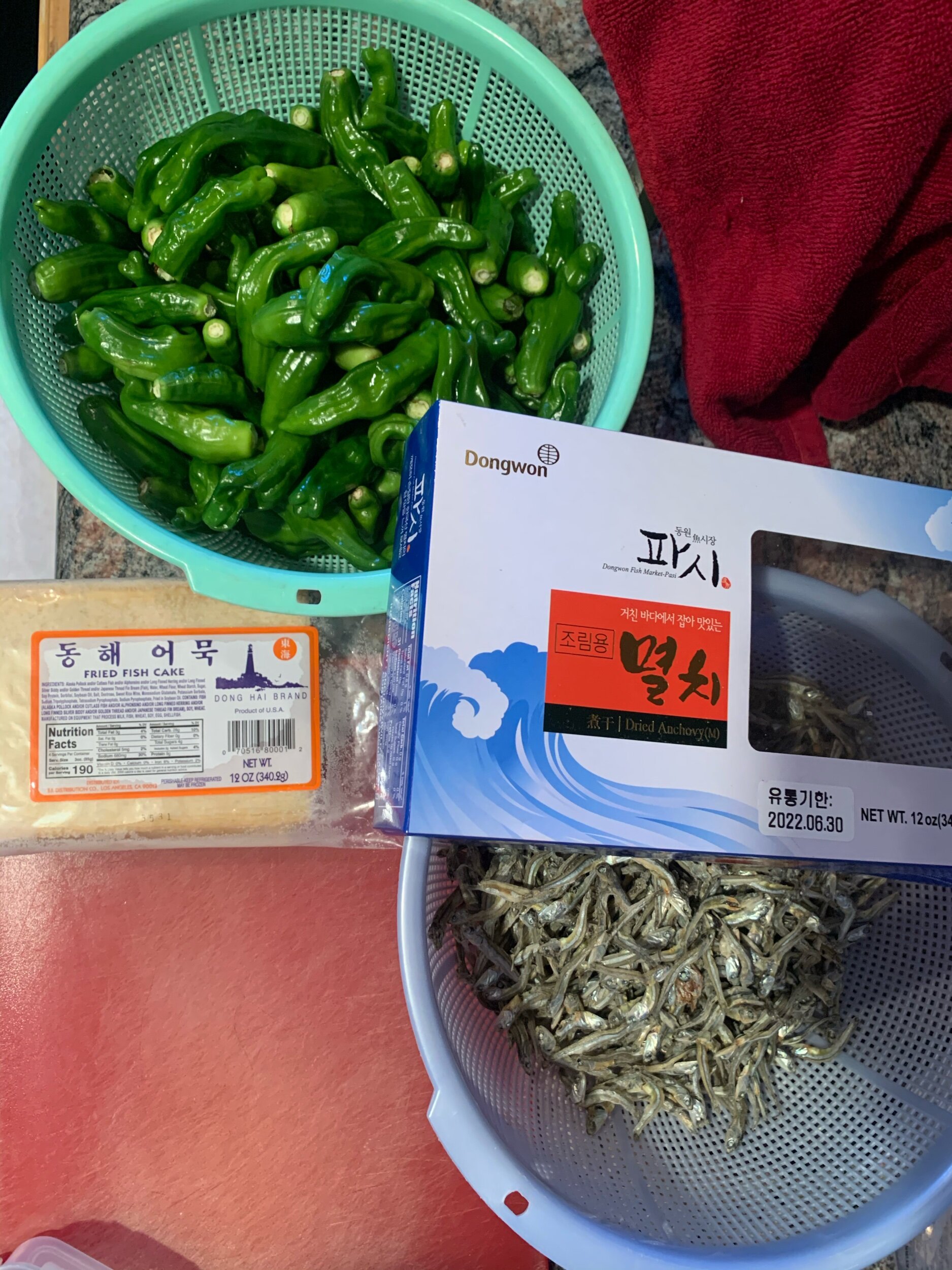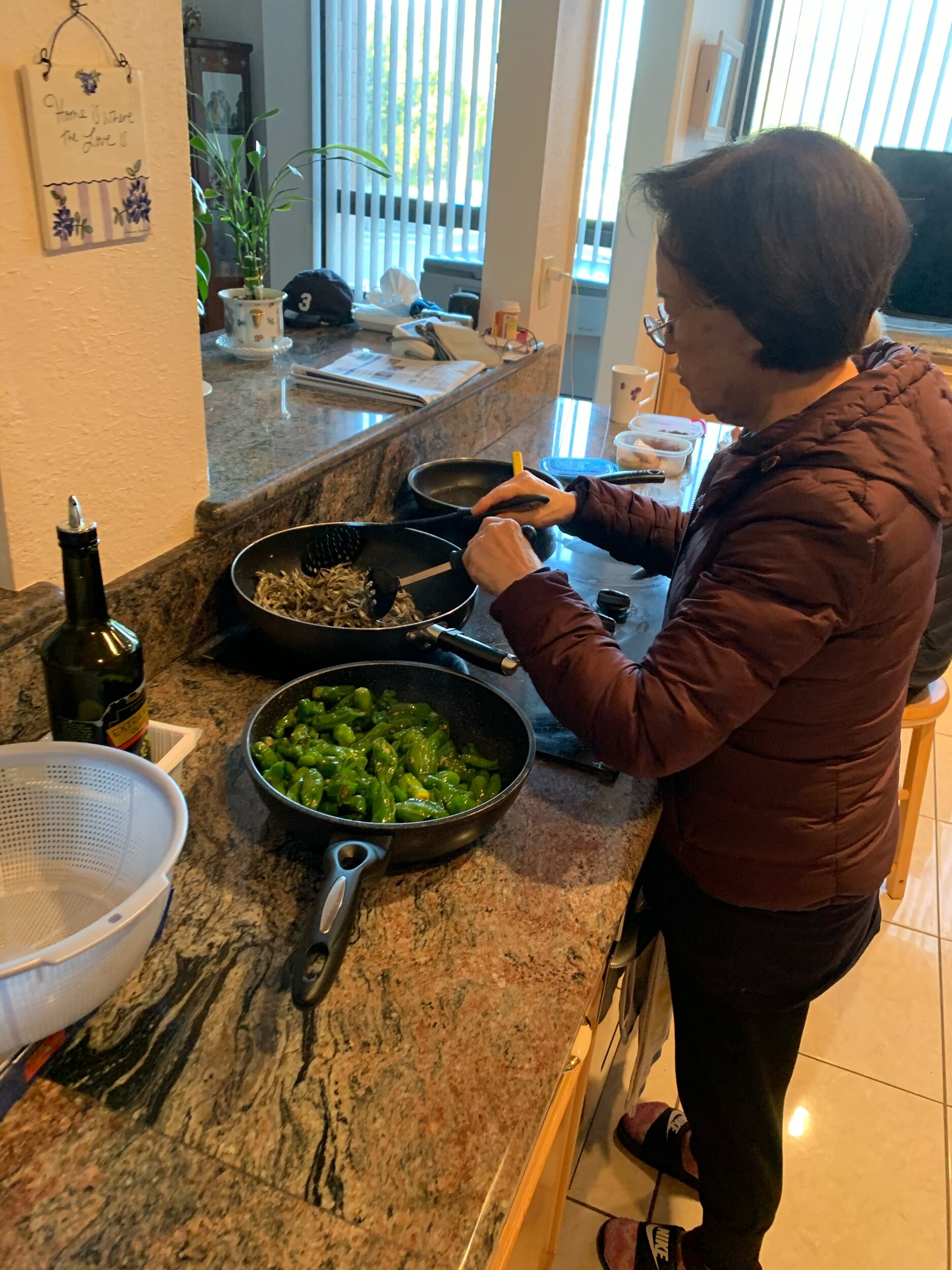The Banchan Bible
your four-part guide towards leading a new banchan-based life
What is banchan?
My family and I standing outside one of our favorite Korean restaurants in LA’s Koreatown—Kobawoo.
If you’ve dined at a Korean restaurant, you will recognize banchan as the spread of small plates brought out immediately as you sit down. While banchan is the first star to grace the stage, it is as much an appetizer as it is a side and even a main. It eludes labels, flirting with every moment of the meal. It is both a singular and plural verbiage. Banchan is such a mainstay through the meal that Koreans don’t use a five-star Yelp rating to review a restaurant, but they use a banchan-scale. Yes, you can judge a Korean restaurant based on its ambience or meat cuts, but banchan truly is the quiet distinguisher.
No, let’s not go there: they serve such a stingy selection of vegetables--only moo (radish) and siguemchi (spinach). They never answer the call button quick enough to refill. You only get the nicer spread if you order the kalbi (bbq short ribs). Let’s go here instead: their kimchi is always ripe. They even serve mook (mung bean jelly), japchae (glass noodles), pa jeon (scallion pancakes), potato salad, and spicy marinated clams.
Banchan most commonly is a selection of lightly marinated, vegetable dishes. Because of its simple preparation, it is easy to judge a restaurant’s generosity: the quality of ingredients and level of caretaking into creating an abundant spread. For, an abundance of food on the table will always remain immigrant love language. Abundance reminds us of times of scarcity and roads it took to detach food from means of survival. Abundance centers us in gratitude for the redefinition of eating for leisure.
While a restaurant-style spread might seem hard to replicate in the home, banchan cooked and served in the home is relatively similar. The produce is cheap, and the seasonings are pantry ingredients. It served communally, never portion-controlled: everyone double-dips his or her chopsticks to add more to their rice bowl. You don’t pass around a platter with a nod or soft smile. Arms reach over one another. Chopsticks cross. But eating is not a contest for the most ravenous and of most nimble because small plates seem never-ending. At restaurants, they are refilled like water glasses, and at home, they are cooked in large batches.
The only difference between the restaurant and home is perhaps that the variety of banchan. While you can expect relatively the same banchan eating out, banchan changes day-to-day at home. Korean families will cook one or two new banchans each day so that a hoard is well-maintained and multiplied daily. As one store runs out, two more replace it. It grows effortlessly. The only question then becomes: where does one start?
How to use the Banchan Bible:
The Banchan Bible is a comprehensive, approachable guide to help you get the banchan ball rolling. I chose staple recipes specifically from my grandmother’s cooking.
My grandma cooks in a minimalist manner: she tells me, “I like easy life,” which is truly the life she deserves as a Korean-American immigrant. As a single mother, she left home and her only child--my mother--behind in her early twenties to build a new life in America. After she built a foundation of a new American life, she was able to bring over my mother and later her mother (my mother’s grandmother). (Sound familiar to a recent Oscar-nominated feature film?)
She worked odd jobs in America all her life, so she only learned how to cook after retiring in 2012. She learned how to cook very much like a younger generation. She takes inspiration from recipes forwarded to her on Kakao and from YouTube algorithm. Because her training is based on short-form new media, her “easy life,” cooking style can help you get started.
The guide includes only four recipes--four of my favorite base recipes that I’ve eaten time and time again in so many iterations. You can vary the spice level (even omit the heat entirely), substitute seasonal greens, and mix and match suggested ingredients. The Banchan Bibles becomes more than four recipes but a curated guide. You’ll also find my grandma’s “easy life” cooking techniques to help you learn your way around a Korean kitchen and pantry.
Speaking of “easy life”, because my grandmother’s pantry is so simple--substitutions are not just out of the question but they are not even on the table in the first place.There are no easier substitutions for her pantry. If you’re familiar with volume measurements, your new “easy life” does not even have to include washing multiple teaspoons and tablespoons. During recipe developments, all pantry ingredients were not precisely measured but eyeballed and added to taste. I included measurements as a starting point, so measure the starting amount and then adapt to your taste. Sprinkle a little more here or pour a little more there.
Cook how the guide was developed--intuitively. Follow the large-batch instructions, and the banchan will keep for the weeks to come. (Banchan walked, so meal prep could run.) Try a new one each day or week, adding to your banchan hoard. Eat with a steaming bowl of rice, in sanchu ssam (lettuce wraps), on top of a slaw of raw veg, or as a snack.
Your Korean Pantry:
Garlic salt
Garlic powder
Gochugaru
Gochujang
Oligodang or Honey or Corn Syrup
Soy sauce
White sugar
White sesame seeds
Sesame oil
Frying oil*
Optional: MSG*
*My grandma uses a mixture of EVOO and canola oil. You can use any neutral oil though too.
**MSG is not bad for you. I only denote MSG as optional because it is not necessary to add but will only help amplify and blend the flavors.
5-second, garlicky greens
(siguemchi namul)
Yes, you read right. 5-seconds.
Servings: 3-4 servings
Time: 5 minutes
Ingredients:
1 large bundle of spinach (but you can use any greens: kale, perilla leaves, beets tops, etc.)
From your pantry:
1/2 tsp Garlic salt
1/4 tsp Garlic powder
1 tbsp Sesame oil
1 tbsp Sesame seeds
Recipe:
1. Boil water. Blanch greens.
To blanch greens: Put greens in colander and submerge in boiling water for 5 seconds.
2. Rinse greens under cold water. Squeeze water out of greens so that you form a few tightly formed balls.
3. In a mixing bowl, loosen greens. Season with pantry ingredients to taste. Mix.
Voila greens! Store in refrigerator for up to 2 weeks. Eat cold.
See recipe development for 5-second, garlicky greens here.
If you decide to cook some greens, please tag me @everythingalexcooks,
(and I mean actually tag me, the new IG update doesn’t notify me when I simply get mentioned in a caption).
I want to see your creations and hear your thoughts!
korean-style shishitos
(kkwarigochi)
My mouth gets bored quite easily, but this crispy, juicy, and smoky mix returns a new experience with each bite.
Servings: a shit ton of shishitos
Time: 15-20 minutes
Ingredients:
4-6 tbsp olive oil (or neutral oil)
2 lbs shishito peppers, cut in halves
½ cup dried anchovies*
1 12 oz package flat fried fish cake, cut into triangles*
From your pantry:
½ tsp Garlic salt
½ tsp Garlic powder
2-3 tbsp oligodang or honey or corn syrup
White sesame seeds
Optional: a sprinkle of MSG, 1 tbsp gochugaru
*Feel free to mix and match dried anchovies and fish cakes. You can do a combination of just peppers and anchovies, peppers and fish cakes, or all three--peppers, anchovies, and fish cakes.
Recipe:
1. Add anchovies into the colander. Shake colander to remove and discard anchovy “dust.”
“Easy Life” Skill #1 -- “Shake and Discard” -- Shake to discard small broken pieces and “dust.” Small pieces and “dust” cause uneven cooking and will quickly burn otherwise.
2. In a large pan with high walls, heat 2 tbsp oil on medium heat. Once oil is glossy, add dried anchovies. Scoop and toss. Fry until anchovies take up slightly golden color (~5 minutes). Remove anchovies from pan and set aside.
“Easy Life” Skill #2 -- “Scoop and Toss” -- Use two large cooking utensils (such as two large cooking spoons). Hold utensils on opposite sides of the pan (e.g., one utensil at 3 o’ clock and the other at 9 o’ clock.) Bring the utensils towards the middle to scoop and toss ingredients towards the front of the pan. If you do not continually scoop and toss, the ingredients will burn.
“Easy Life” Skill #3 -- “Cook by color” -- Because you are continually scooping and tossing, you can time the cooking by eye. Mind the color, not the clock.
3. In the same pan, add 2 tbsp oil. Once oil is glossy, add cut shishito peppers. Using the same scooping technique, scoop and toss until shishitos are cooked through and have slightly colored spots (~ 5 minutes). You do not want blistered shishitos. Remove shishitos and set aside.
“Easy Life” Skill #4 -- “Cut with Scissors” -- Kitchen scissors are a Korean grandma’s best friend. Cut shishitos in half (width-wise or hamburger style, NOT lengthwise or hot dog-style) using kitchen scissors.
“Easy Life” Skill #5 -- “Use the same pan” -- Consecutively cook each ingredient separately but in the same pan. The previous ingredient will leave aromatics for the next to build flavor.
4. In the same pan, then add 2 tbsp oil. Once oil is glossy, add fish cakes. Scoop and toss. Fry until slightly crispy and golden (~5-8 minutes).
5. On low heat, return anchovies, shishitos, and fish cakes to the pan. Add garlic salt, garlic powder, MSG, gochugaru, and oligodang. Scoop and toss.The mixture should now be slightly sticky and glossy. Sprinkle sesame seeds to lightly coat. Scoop and toss. Serve immediately.
Use ingredient measurements as a starting point. Add more seasonings and spice to your taste.
Voila fish and peppers! Store in the refrigerator for up to 2-3 weeks. Eat cold straight from the refrigerator or reheated in microwave.
See recipe development for Korean-style shishitos here.
If you decide to cook some peppers, please tag me @everythingalexcooks,
(and I mean actually tag me, the new IG update doesn’t notify me when I simply get mentioned in a caption).
I want to see your creations and hear your thoughts!
honey walnut myeolchi
(fried dried anchovies)
my favorite banchan in the Bible (and 2nd favorite banchan of all time)
Servings: a school of little fishies
Time: 10 minutes
Ingredients:
4 tbsp olive oil (or neutral oil)
12 oz raw walnuts
12 oz dried anchovies
From your pantry:
Garlic salt
Garlic powder
Oligodang or Honey
White sesame seeds
Optional: 2-4 tbsp gochujang sauce*, MSG
*gochujang sauce: 1 tbsp soy sauce, 2-3 tbsp gochuchang, 1 tbsp oligodang, 1 tbsp sugar (this will make more than you need. You can store the excess in the refrigerator and eat with bibimbap, use in any stirfry, or add your gochujang eggplant pasta).
Recipe:
1. Add anchovies into a colander. Shake to discard anchovy “dust.” Set aside anchovies. Then repeat with walnuts: add walnuts to colander and shake to discard walnut “dust.”
“Easy Life” Skill #1 -- “Shake and Discard” -- Shake to discard small broken pieces and “dust.” Small pieces and “dust” cause uneven cooking and will quickly burn otherwise.
2. In large pan with high walls, heat 2 tbsp olive oil on medium heat. Once glossy, add anchovies. Scoop and toss. Fry until anchovies take up slightly golden color (~5 minutes). Remove anchovies from and set aside.
“Easy Life” Skill #2 -- “Scoop and Toss” -- Use two large cooking utensils (such as two large cooking spoons). Hold utensils on opposite sides of the pan (e.g., one utensil at 3 o’ clock and the other at 9 o’ clock.) Bring the utensils towards the middle to scoop and toss ingredients towards the front of the pan. If you do not continually scoop and toss, the ingredients will burn.
3. In the same pan, heat 2 tbsp olive oil on medium heat. Once glossy, add walnuts. Scoop and toss walnuts until golden (~2 minutes).
4. Turn off the heat but keep the pan on the burner. Return the anchovies to the pan. Add pantry seasonings (garlic salt, garlic powder, MSG, oligodang) and gochujang sauce. Sprinkle sesame seeds to lightly coat. Toss and serve immediately.
Use ingredient measurements as a starting point. Add more seasonings and spice to your taste.
Voila fish and nuts! Store out on counter at room temperature or 2-3 weeks.
See recipe development for myeolchi banchan here.
If you decide to cook some myeolchi, please tag me @everythingalexcooks,
(and I mean actually tag me, the new IG update doesn’t notify me when I simply get mentioned in a caption).
I want to see your creations and hear your thoughts!
dubu jeon
(fried tofu cakes)
the Tofu better watch out. there’s a new tofu recipe in town.
Servings: too many cakes (40+ mini cakes, or 4-5 servings)
Time: 35-40 minutes (active), 45-50 minutes (total)
Ingredients:
1 18 oz package of firm tofu
½ white or yellow onion, diced
¼ cup green onion, diced
1 large carrot, diced
2 eggs*
⅓ cup potato starch**
⅓ cup Korean Pancake Mix***
Generous amounts of olive oil (or neutral oi)
Optional: 1 cup aged kimchi, chopped
From your pantry:
½ tsp Garlic salt
1 tsp Garlic powder
*Vegan friends-- a note on egg substitutions: The egg primarily works as a binder. While I have not tested it, I presume a flax egg could work. A flax egg version might come out a little denser as well.
**Do not substitute potato starch for cornstarch. See recipe test #2.
***Can sub for ⅓ cup all-purpose flour, sprinkle of baking soda and onion powder
Recipe:
1. Press tofu for 10 minutes. Drain water.
To press tofu: 10 minutes is key. Any longer and too much water will drain out, leading to dry cakes. Any shorter and not enough water will drain out, leading to wet cakes.
2. In a large bowl, use your hands to crumble tofu into small pieces--smaller than pea-sized. Add diced vegetables, eggs, and chopped kimchi (optional).. Mix.
3. Add pantry seasonings, potato starch and pancake mix. Mix.
4. Using hands or utensil, tightly compress the mixture towards the bottom of the bowl.
5. Measure out 1 tbsp balls and form balls in cupping and rolling motion between your hands. The more tightly you form the balls, the more uniform the cakes will turn out. You should make 40+ balls.
6. On medium heat, add generous amount of oil to pan. Once oil is glossy, add 6-8 balls to the pan. Do not crowd the pan. Using a spatula, flatten the balls. Fry on the first side for ~ 5 minutes (but timing will depend on pan size and burner).
Sacrifice one cake (preferably the first cake you placed on the pan) to check color every couple minutes. Do not fiddle, touch, or poke at the other cakes. Leave the cakes alone. TWSS.
You may want to use 2-3 frying pans here to cook batches simultaneously and speed up the process .
7. Once golden, flip cakes. Fry second side for ~3-5 minutes. Once the same sacrificial cake is golden, remove all cakes from pan.
“Easy Life” skill #7— Flip, using a spoon and spatula — Use the spatula to lift and turn the cake over quickly. Use the spoon to soften the cake’s landing onto the pan.
Voila vegetables and beans! Store in the refrigerator for up to 1 week. Reheat on fry pan.
See recipe development for dubu jeon here.
If you decide to fry some tofu cakes, please tag me @everythingalexcooks,
(and I mean actually tag me, the new IG update doesn’t notify me when I simply get mentioned in a caption).
I want to see your creations and hear your thoughts!
Recipe Development:
On March 11, a white man murdered 8 victims in Atlanta, and Asian-American hate crimes, which have been escalating since the start of the pandemic, finally made large-scale media news. Six of the 8 people murdered were Asian-American women, and three of them Korean-American women. Back in June 2020, after the murder of George Floyd, the Black community called for people to stop sharing the taped evidence of those eight minutes and 38 seconds. Watching that video, the Black community saw their brother, their uncle, and their father in Mr. Floyd. I am not Black, and I will never know what the Black experience is like. However, seeing videos of elderly Asian-Americans brutally attacked on the subway and streets and reading news of a mass shooting, I’ve seen my community in these elders and my family in these women. I am not comparing the racial intersections of police brutality and slavery to xenophobia and fetishization. But I am comparing the emotional trauma and affect induced by watching these violent videos. I relate to a collective BIPOC experience in which we are victims to large-scale media corporations who exploit racist violence as trauma porn.
I’m numb. There are so many variables to unpack in the Atlanta shooting. How do you fight back against all these intersectional variables--mass media fetishization, colonization, sex worker rights, coronavirus lashback fueled by a xenophobic president, gun violence, etc.? I am though with the one variable that angers me the most—the fetishization as Asian-American as quiet and sexually submission. As a small, Asian-American young woman, I do not want to be squared into a box.
So, over the past few weeks, I’ve been standing on my box, this platform, and attempted to tear down this monolith. Through sharing my grandma and her recipes, I hope that I’ve helped to subvert the trope of the demure Asian-American woman. My grandma has become a popular recurring character in her puffer vest on my IG stories. Her comical expressions and unapologetic personality have won over many fans. (She’s the Community’s Korean grandma now.) The videos of my grandma cooking through all four recipes is saved to my IG highlights. I’m attempting to trash the canon and rewrite the script. My grandma is a nuanced character, gentle but clever and understanding but resilient.
Test #1, February 13, 2021 - Last August 2020, my grandma introduced a new banchan into our lives: dubu jeon. It has quickly become a weekly family favorite. She initially was inspired by a YouTube video that she watched, but I’ve seen the dish evolve throughout the months. I wanted to put an additional spin on it: adding kimchi and zucchini. I will usually eat original version of the dubu jeon with a soy sauce-vinegar-water dipping sauce because it feels like it lacks some tang. I hoped adding kimchi would eliminate the need for the dipping sauce. Zucchini is used in a lot of Korean vegetable pancakes, stews, and even as a simple banchan seasoned with sesame oil and salt. We tested the original version and my new take.
What we did right: Rather than adding heat, the kimchi added a necessary lactic tang. I did not need any dipping sauce.
Needs improvement: The cakes did not cook through because there was too much moisture. The water leached from the tofu and vegetables (carrots and zucchini) and kimchi juice made the batter too wet. The cakes were hard to flip.
Test, #2: March 3, 2021 - I cooked the tofu cakes on my own, tweaking the technique and testing substitutions. I wanted to eliminate excess moisture: 1) pressing the tofu first 2) only using carrots. I also wanted to test some pantry substitutions: cornstarch for potato starch, real garlic for garlic powder and garlic salt, and whole wheat flour for Korean pancake mix. Lastly, I julienned instead of diced the carrots for aesthetic purposes, giving the cakes more visual texture.
What I did right: I used a ½ block of leftover tofu, so I halved the recipe. I measured ingredients with cups and spoons so that I could translate my grandma’s eyeballing. While forming the balls, I discovered that a golf ball shape is equivalent to ~1 tbsp. Half-way through cooking, I realized that I did not compress the balls tight enough (or perhaps there was not enough moisture). The tighter balls created more round cakes once pressed.
Needs improvement: Pressing the tofu heightened the crispy texture. However, pressing the tofu for 30 minutes,I think I got rid of too much moisture because the cakes were a bit dense and dry. The dryness could also be due to the addition of whole wheat flour, which absorbs more moisture than white flour. The cakes (both the original and kimchi versions) were practically tasteless without the garlic powder, garlic salt, and potato starch.
Test #3, March 16, 2021 - For the last dubu jeon test, I decided to cook with my grandparents. I got one more look at their eyeballed pantry ingredient measurements and cooking techniques.
What we did right: I pressed the tofu for only 10-15 minutes this time. The tofu retained enough moisture to help bind the ingredients but not too much moisture so that the cakes couldn’t cook through. The cakes flipped easily with my grandma’s spatula and spoon method. Using my grandma’s trusty pantry ingredients, the flavor returned. This iteration had the best texture yet: a plush interior with a crispy exterior. My grandma and I ate so many cakes, strategizing upon seasons and timing in which she would visit for (so that my mother wouldn’t get jealous) after I move.
Test #4, March 24, 2021 - Many of the ingredients in my grandma’s kitchen do not have English counterparts or translations. I’ve always thought her green pepper dish tasted like shishito peppers, but I did not want to assume it was. After all, shishitos are normally cooked in Japanese cuisine (and you know how Korean elders feel about Japanese cuisine). I asked my grandma the name of the peppers: kkwarigochu, which translates to twisted peppers. I googled the transliteration, and shishitos were the first hit. My grandma will make her kkwarigochu either with packaged flat fish cakes or myeolchi, but I told her I wanted to try and mix all three in this iteration.
What we did right: I learned so many new cooking techniques in this test: from the scoop and toss to cook with color. The trio of ingredients provided a variety of taste and texture. My mouth gets bored quite easily, so I loved picking at different bites. The anchovies provide a tiny crisp, the fish cakes provide a juicy chew, and the shishitos provide more fibrous, vegetal morsels. I also learned about a new ingredient: oligodang. Oligodang is an oligosaccharide--a sweetener that Koreans use as a healthier take on corn syrup and cheaper take on honey. Oligodang also contains an active bacteria, , with gut benefits, so it is important to add it at the end (much like how one would add miso only at the end of miso soup to maintain its health benefits.
Test #5, March 29, 2021 - Myeolchi banchan is my second favorite banchan overall and is my favorite in the Banchan Bible. (My favorite banchan is gosari namul: wild fernbrake.) I will eat myeolchi like potato chips, snacking on them mid-day. There’s always a container that sits on our kitchen counter.
My grandma normally makes a non-spicy version so that my mother can tolerate it. My mother’s gut cannot tolerate any spice; I think her Korean card should be revoked. While I have a hard time with Indian, South East Asian, and Mexican spice, I love Korean red pepper spice. I think other cuisines have a more back-of-the throat burn or whole mouthfeel heat while Korean spice turns toward the front of the palate. I told my grandma that we should add gochugaru to the myeolchi as Korean restaurants and markets do.
What we did right - Instead of adding gochugaru, we decided to add a gochujang sauce--the same kind of sauce one would use for bibimbap and the same kind of sauce I modeled my gochujang eggplant pasta afterwards. Using gochujang instead of gochugaru added a more nuanced flavor with tang and sweetness.
Test #6, March 30, 2021 - 5-seconds? It takes less than 5-second to blanch your greens. Sigeulmchi translates directly to spinach, but my grandma will use a variety of leafy greens. When kale started trending, my grandma started making 5-second, garlicky kale. When she has leftover beet tops, she makes 5-second, garlicky beet tops. When perilla leaves are on sale, she makes 5-second, garlicky kkaenip (perilla leaves).
We made the classic iteration with spinach in less than 5 minutes. I walked down to my grandma’s place, and I walked back up in 5 minutes. This recipe is no-frills and three steps. (We live in the same complex. She lives on a unit on the first floor, and I live in a unit on the third floor.) I eat sigeumchi namul with steaming rice or in bibimbap.
What we did right - I learned to season by eye and taste. This recipe does not require you to measure. Its technique and ingredients are simple enough that you can season to taste. I did leave starting measurements though, so you don’t end up adding 1 cup of sesame oil. My measurements were eyeballed to the best of my ability. As a visual learner, I do tout my eyeballing volume measurements though.

